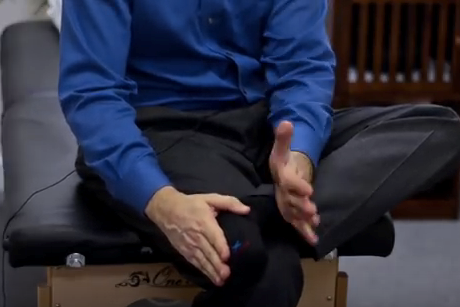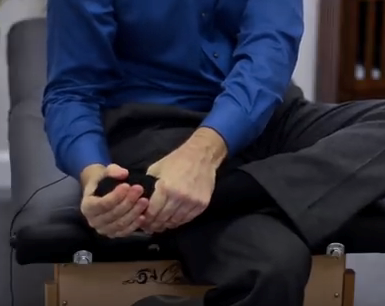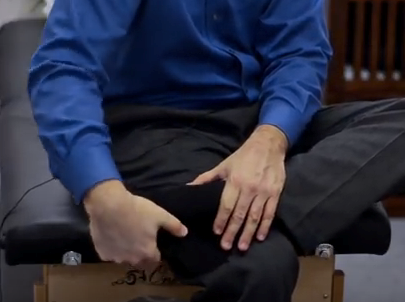The article which you are about to read is the result of a study conducted by E. Durak, MSc and it was interesting to us from two aspects. First it discusses the alternative self-care version of Plantar Fasciitis therapy. Secondly, it greatly illustrates the necessity of the patient’s involvement in the treatment process in the form of therapeutic homework which the therapist should use as an additional clinical tool.
Dr. Ross Turchaninov, Editor in Chief
The Effects Of Dorsi Stretches On Perceived Pain Levels In Plantar Fasciitis Sufferers: A Self-Selected YouTube Survey
By Eric Durak, MSc, Santa Barbara, CA
ABSTRACT: We analyzed the results of 71 people who self-selected to a survey on pain level changes after watching a YouTube video on relieving pain levels in Plantar Fasciitis. These responders (70% women, 30% men) had perceived pain levels ranging from 3 to 10 (on a 10 point scale), and after performing simple stretches for five minutes up to multiple times a day for two weeks, responders felt significant pain relief.
The stretches consisted of pulling the toes into a dorsi stretching position for up to a minute at a time, rolling the hands from mid foot to the end of the toes. This is accomplished by taking off shoes and working either barefoot or through socks. Results indicate pain levels were reduced from 7.84 + 2.1 to 1.97 + 2.8 (p<0.0001).
This reduction of almost four-fold was hailed by each person as an innovative method for reducing their chronic pain levels in Plantar Fasciitis compared to all previous methods that they had tried.
Conclusions: That performing a dorsi flexion method for five minutes or less each day has significant reductions in Plantar Fasciitis pain in persons with moderate to severe pain levels. Surveys on larger numbers of responders would help quantify the technique as a bona fide healing method that could be self-prescribed, and self-performed by persons suffering from chronic Plantar Fasciitis and related foot maladies.
KEY WORDS: Plantar Fasciitis, pain management, foot massage, pain levels, self-care, foot care, dorsal tendon stretch
INTRODUCTION
Plantar Fasciitis (PF) is a common chronic foot ailment that affects up to 2 million people annually. According to the American Association of Orthopedic Surgery, the majority of these patients are also treated for concomitant bone spurs (Durak, 2016). Treatments may include splints, surgery, physical therapy, wrapping, or a combination of any of these modalities (D’Maio et al., 1993; DiGiovanni et al., 2003). In an attempt to reduce suffering, You Tube videos from therapists such as Bob Schrupp and Brad Heineck (physicaltherapyvideo.com) use traditional remedies such as pressure point and plantar stretches to relieve pain symptoms from Plantar Fasciitis (2).
One remedy used with industrial workers over many years is the use of “pre orthotics” which are inserted into work shoes and used all day. Over the years this program improved PF foot pain from an average of over 5 (on a 10 point scale) to 1.66 – a very mild pain level that did not interfere with work efforts (Durak, 2016).
The question of using simple methods for pain relief is touted in both the health literature and from companies who provide products for pain relief. The study by Durak on the use of pre orthotics found that self-assessed pain levels decreased in industrial workers who wore the inserts in their work boots during the course of the day. It is one of the first reports to look at commercial products and their long-term effect on reducing pain and keeping it at bay over many years.
In one of his consumer education videos from You Tube, Dr. Eric Berg (1) discusses a simple method to alleviate pain levels in the foot from both PF, and also flat feet. His theory is that most physicians and physical therapists tell patients to stretch the actual PF tendon multiple times on a daily basis. Dr. Berg suggests that the more important method for reducing pain is to perform a dorsi flexion on the feet (the opposite direction) by pulling all of the toes in a dorsi flexion position, back to neutral, and then repeat up to 10 times for a few seconds each. He also states that for persons who have a hard time performing this stretch, they could sit in a yoga position with the feet directly under the hips and buttocks, where again the feet are in a dorsi flexed position.
How may this work? It seems counter-intuitive to traditional methods for PF therapy (direct stretch, ice, immobilization, night splints). From Berg’s perspective, stretching the dorsal side of the foot may do two things – first, not put additional pressure on the fascia that is already damaged. Second, help align the entire foot biomechanics from the “top down” so that when body weight pressure is applied, it is more natural in gait and push off (12).
After sitting in this position for 30 seconds to one minute, the person would shift to a normal sitting position, and rate their perceived level of pain from the beginning to the end of the stretch. His scale is 0 = no pain at all, 1-3 = mild pain, and 10 = excruciating pain levels -not able to walk (Landorf K et al, 2010). By using both the dorsi stretching method by hand, or in the sitting motion, Dr. Berg states that patients can find immediate relief from their pain. He also states that conventional methods of stretching (hyper flexing the toes, calf stretches sitting or standing, or using a plantar stretching boot) are all contraindicated in terms of their actual effectiveness – and may make the situation worse for the patient.
METHODS
Dr. Berg describes the method of dorsi flexion stretches while sitting on a treatment table wearing socks (Figure 1). He performs the stretch for about 3-5 seconds, and repeats the procedure 10 times on each foot placing his hands cupping over the toes (metatarsals 1-5) and detailing that the stretch should be felt all the way up the tibialis anterior (front muscle of the lower leg – Figures 2-3). He pulls the toes towards the bottom of the foot (versus pulling away from the foot as most calf stretching methods dictate). If this is too painful for patients, Dr. Berg suggests sitting in a yoga position with the feet directly under the hips and buttocks, with the feet again contracted towards the ball of the foot (1).
In his videos he asks his patients to try this technique, and rate both at the beginning and end of the program their perceived pain levels from 0 to 10. He requested they write these values down in the comment section of the You Tube video.
The scores from the comment sections were listed in a pre and post numerical value. Gender was derived from the commenter’s posted name and photo, and any multiple submissions were crossed referenced to make sure that the same numbers were not used twice. Pre and post values were put into a Student’s T-test statistical web site, and calculated as a two-tailed test (11).
Since the comments listed within You Tube are both public domain, and persons use a log in name (not their own) to place comments, this survey does not qualify for institutional review board review or expedited review, as no actual experimentation took place on subjects and no private information was used under HIPAA regulations.
RESULTS
The results of his method survey were posted on you tube, and the first 207 responses were reviewed. Of those first 207 (70% female respondents, 30% male) a total of 71 persons detailed their pre and post survey pain levels, and the amount of time they spent practicing the Berg method for PF pain relief.
The time spent actually performing the stretch was from five minutes to four days. The table below looks at the range of time that viewers performed the program stretches after watching the video (N = 68). Three people declined to discuss the actual amount of time they used the technique.
| 5 min | 10 min | 15 min | One Day | Two Days | One Week | Two Weeks |
| N = 10 | N = 14 | N = 9 | N = 27 | N = 2 | N = 5 | N = 4 |
Table 1. Range of time responders used self-stretching to alleviate pain levels in their PF after watching a You Tube video.
The majority of the responders felt that performing the stretching program multiple times over one day afforded them the best relief from pain levels. Those who performed the stretch once (five minutes) had an outstanding level of pain relief (from 9 to 2), and those who performed the stretch for only 10 minutes (N = 14) also had remarkable levels of pain relief (from 7 to 1.2 average).
Average pain levels for all respondents in this category (N = 40) declined from 7.77 + 1.95 to 1.98 + 2.7 (p<0.0001). This highly significant level was seen in both men (N = 11), and women (N = 29). A level of seven (Durak, 2016) on the pain scale is extremely high, and affects every level of movement and work. Most people who suffer pain levels at this range would be hampered from doing their normal job duties, and activities for daily living (ADLs). However, pain scales at the level of 1.98 (essentially 2) are very moderate, and would not interfere with work settings – even those that would include working on a ladder, scaffolding, or other device that may dig in directly to the arch of the foot – aggravating Plantar Fasciitis (4).
DISCUSSION
One of the issues with self-described pain levels is the use of “10” as a starting point to pain levels. In my years working in injury prevention, when we had workers describe PF pain levels, they would start with “10” until I reminded them that most pain levels that high would entail large deep cut wounds, fractures, or tendon severs off the bone. I would describe that the highest levels of pain that could be walked on as a pain level around 6-7. We had 11 responders use “10” as their starting pain levels (six responders start at “9”, and seven responders start at “8”). The lowest pain level for any person at the start of their stretch program was “4” (and five responders starting at a moderate pain level of “5”) (Durak, 2016 ;7).
Whether pain levels are extremely high, or moderate, the issue of using this type of treatment to reduce pain and improve function is of importance. Most medical remedies include X-rays, physical therapy for moderate levels, and perhaps medication and /or surgery for high pain levels. In any of these cases, there is a lot of time and expense involved in the healing process. Other types of remedies include ice therapy, general foot massage (self or therapist), taping, or a combination of these modalities. Although not as time consuming or expensive – they may involve regular self-care and diligence in order to make long-term changes in pain status (Irving et al., 2008).
Other research methods look at plantar heel and foot stretches as the main activity to reduce pain and improve mobility in pain sufferers. In Sweeting’s review – multiple studies were reviewed in a meta-analytic report ( Sweeting et al., 11). They found little difference between static plantar stretching and control, or alternative methodologies in many of their review reports. This begs the question if the use of plantar flexion in and of itself is the primary method that should be employed, or are there other types of interventions (such as Dr. Berg’s dorsi flexion technique) that may have stronger results, but are not recommended to patients.
Dr. Berg’s simple method is complete self-care massage / stretching technique – costs no money, improves pain levels in a relatively short period of time in this self-selected group, and may have long-lasting effects. We believe that this method may have an important contribution to healing PF, and would urge a larger sample size controlled study to verify the results in different population groups (seniors, post-surgery patients, persons who have had diagnosed PF for over one year in duration, industrial workers who use ladders or stepping platforms, hair stylists who stand for hours at a time). It would have tremendous ramifications relating to health care issues and costs by using this method. Finally, Dr. Berg’s method should be used in combination with other techniques and modalities to achieve a comprehensive approach to the rehabilitation of patients with PF.
Disclosures: We disclose no financial ties to any industry sponsors, or Dr. Berg in the preparation of this manuscript. Dr. Berg was contacted prior to submission of this manuscript. He did not respond.
REFERENCES
1. https://www.youtube.com/watch?v=gXdlPuKfyXs
2. https://www.youtube.com/watch?v=S30nHV5A5Os
3. http://www.orthoinfo.aaos.org/topic.cfm?topic=a00149
4. http://www.wongbakerfaces.org/
5. DiGiovanni B, Nawoczensk D, Lintal M, Moore E, Murray J, Wilding G, Baumhauer J. Tissue-specific plantar fascia-stretching exercise enhances outcomes in patients with chronic heel pain: A prospective, randomized study. J Bone Joint Surg Am. 2003;85:1270–1277
6. D’Maio M, Paine R, Mangine R, Drez D. Plantar fasciitis. Orthopaedics. 1993;16:1153–0063
7. Durak, EP. The Use of the Power Step Shoe Insert to Manage Plantar Fasciitis Pain in Industrial Workers: A Seven-Year Pilot Report. J. Ergonomics. 2016; 6(1). http://dx.doi.org/10.4172/2165-7555.1000150/
8. Irving D, Cook J, Young M, Menz H. Impact of chronic plantar heel pain on health-related quality of life. J Am Podiatr Med Assoc. 2008;98:283–289.
9. Landorf K, Radford J, Hudson S. Minimal Important Difference (MID) of two commonly used outcome measures for foot problems. J Foot Ankle Res. 2010. http://www.jfootankleres.com/content/3/1/7
10. Sweeting, D, Parish, B, Hooper, L, Chester, R. The effectiveness of manual stretching in the treatment of plantar heel pain: a systematic review. J. Foot Ankle Res. 2011, 4(19). Doi: 10.1186/1757-1146-4-19. https://www.ncbi.nlm.nih.gov/pmc/articles/PMC3150253/
11. http://www.socscistatistics.com/tests/studentttest/Default2.aspx
12. https://www.drberg.com/blog/the-instant-cure-for-plantar-fasciitis
Correspondence to: Eric Durak, Medical Health and Fitness. 133 Campo Vista Dr. Santa Barbara, CA 93111. edurak@medhealthfit.com 805-451-8072

Figure 1 – Discussion of hand placement for dorsi stretch and why the stretch should be in the top position of the foot.

Figure 2 – Begin with hand placement over proximal phalanges just of the metatarsals

Figure 3 – He begins by pulling the toes toward the arch of the foot for approximately 10 stretches, he repeats up to five times.
Category: Medical Massage
Tags: 2019 Issue #4
